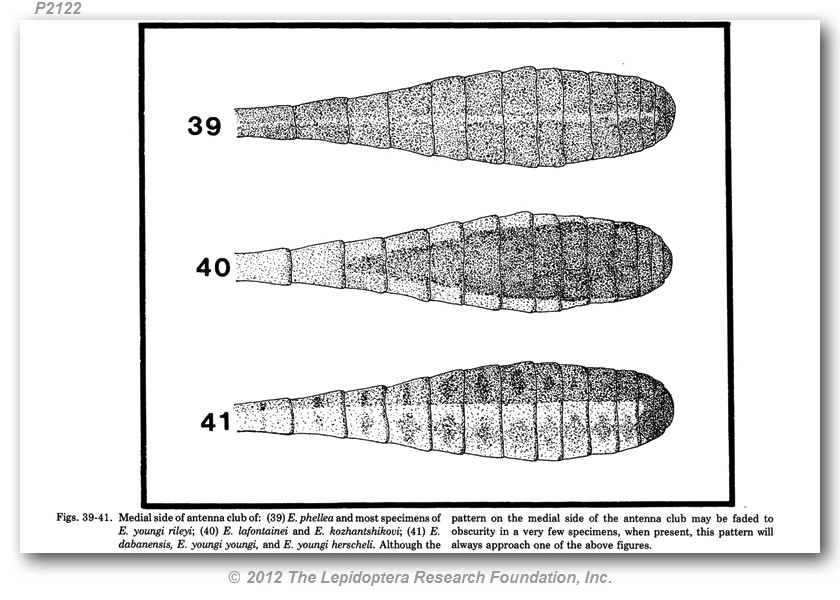
| Feature | youngi | lafontainei |
| Nudum of antenna | dark brown top strip above ochre lower half/two-thirds (fig. 41). | light ochre above and below a central dark brown patch (fig 40). |
| wing fringes | females and some males rarely with checkered by dark vein-points | never checkered |
| DFW | 5 fulvous ocelli usually eliptical or oval | 4 fulous ocelli with black pupils |
| DHW | 0 - 5 large fulvous ocelli with black pupils | 0 - 4 small, dull fulvous ocelli with minute brown pupils or pupils absent |
| VFW | wide submarginal fulvous patch rather than a series of fulvous ocelli | hairs red. Basal area gray-brown with heavy suffusion of bright rust-red scales extending distally to slightly darker postmedian line |
| VFW submargin band | light gray-brown suffused with rust-red scales and containing single fulvous ocelli in M1,M2,M3, CU1 These ocelli may coalesce to form a band and extend out in CU2 ocassionally. Each ocelli with single black pupil | |
| VFW margin | white scales absent in apical area | |
| VHW ground color of postmedian band - (male?) | dark brown -brown with scattering of white scales producing hoary appearance | gray-brown with a smooth, neat appearance; never hoary |
| VHW postmedian band appearance | pinkish due to heavy scattering of pearlescent pink scales over gray-brown ground color | |
| VHW mesial and marginal bands | blackish brown to ruddy brown | reddish brown to maroon - never dark brown or blackish |
| VHW | Hairs red. Basal area dark brown suffused with rust-red scales; postbasal band gray-brown with light suffusion of rust-red scales and very light scattering of grayish white scales near submedian band. Base of mesial band meduim to dark brown heavily suffused with rust-red scales, curved inward along each vein; postmedian band light gray-brown very heavily suffused with perlescent pink and light rust scales; marginal bad light gray-brown very heavily suffused with bright rust-red scales and scalloped inward along veins |
This is the figure from Troubridge and Philip, 1983 that shows the patterns of the underside of the antenna club:

Regarding habitat, the primary location where almost all of these individuals were photographed had drier stony tundra on one side of the road and wetter tundra with scattered low shrubs on the other side of the road:
This is the habitat on the south side of the road (numerous spongy wet patches therein):
This is the habitat on the north side of the road (some parts had less vegetation than in this image):
Most of these alpines were flying over the wetter south side of the road, but a couple were on the drier north side, and at least one flew from the drier side to the wetter side - my impression was that most if not all of these alpines were males flying into the wind looking for females. NOTE: in Troubridge and Philip 1983 it states that: "lafontainei is a denizen of low shrub tundra...adults usually rest in the small patches of short sedge which are found between the low willows and birches.... Adults will often stray over fellfield or scree when their shrub tundra habitat comes in close contact with these other arctic biotopes."
Troubridge and Philip also say that both taxa should be flying in late June (but youngi is typically 1- 2 weeks later in its cycle) and that they can be found together e.g. at mud puddles.
Below are photos of each individual, with my assessment and tentative ID:
1) all visible features seem to fit lafontainei - but see first line on this page:
2) This is more-strongly marked than the one above, but I still feel that all visible features better-fit lafontainei - but see first line on this page:
3) hard to assess - does the PM band look frosty? - but see first line on this page
4) not sure what to make of this one; the FW ocelli seem muted, with the lower two slightly offset outwardly, plus the distal half of the VHW seems rather frosty? - but see first line on this page:
5) Mostly better for lafontainei I think, but is the fringe checkered? - but see first line on this page
6) overall looks like most of the ones on this page - but it is the only one that seems to have the youngi pattern on the antenna club? - but see first line on this page:
7) very reddsih thus strongly lafontainei-ish - but VFW has solid fulvous block which is a feature of youngi - ? - but see first line on this page:
8) the visible features seem to fit lafontainei - but see first line on this page:
9) not much to go on but the visible features seem to fit lafontainei - but see first line on this page:
10) poorly-marked, but probably not IDable from this one photo - but see first line on this page:
11) this one with smallish, less-distnct oeclli which seem to curve outwards slightly (going backwards)- ? - but see first line on this page:
12) the fringe looks to be distinctly checkered, and although the rear of the antenna is not visible, the top seems blackish... youngi? - but see first line on this page: